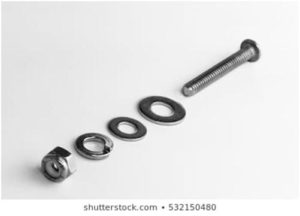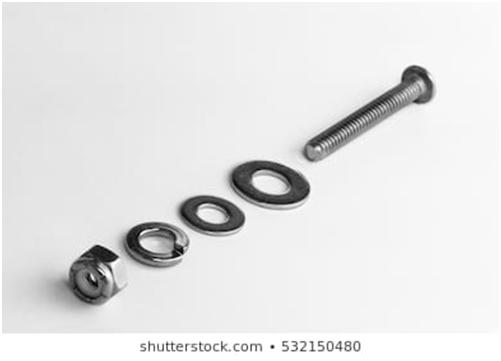Is the lock washer without flat washer way really the best? If you have attempted all kinds of research and just can’t find a conclusive answer to this question, you are not alone. Neither have the experts.
As a civil engineering student, I have access to some of the greatest minds in the engineering world. I have posed the question of whether lock washers should be used alone or with flat washers to a few of them and they seem to have opposing standpoints.
Image courtesy of Pixabay

The purpose of a flat washer is to distribute the clamping force of a tightened nut over the area of the clamped material. The lock washer serves to prevent nuts and bolts from coming loose by slipping or turning caused by torque or vibration. There are many different types of lock washers, all of which perform this function in slightly different ways.
Types of Lock Washers
The many different types of lock washers fall into one of two categories:
Spring Action Lock washers: These are also be referred to as spring washers.When a spring washer is placed under a nut or screw head, it is compressed as the fastener is tightened. When the fastener is subjected to vibration, the spring-back tension prevents loosening. Spring washers also help to prevent material wear because of their ability to spring back. Examples of spring lock washers include Belleville spring washers, curved spring washers, finger spring washers and wave spring washers.
Tooth Lock Washers: These utilize ratchet action to bite into the nut or screw head and other surface it comes into contact with. Tooth lock washersare common though they are known to cause scratches on surfaces they come into contact with. Examples of tooth lock washers include external tooth lock washers, internal tooth lock washers, countersunk external tooth lock washers andinternal-external toothlock washers.
There has been debate among engineering and other related industry experts about the use of lock washers and flat washers. Some say the two should be used together while others say it is best to have a lock washer and no flat washer.
Those in support of the lock washer without flat washer system put forward the following arguments:
- The lock washer’s function is to ‘lock.’ It does this by digging into the fastener and the material being fastened. When a flat washer is present, the lock washer doesn’t come into contact with the material being fastened so it cannot lock into it.
- When tooth lock washers dig into the surface, this improves conductivity for enclosed sections which require grounding for purposes of EMI.
- Inability to maintain design preload and effective lock washer use at the same time.
- What is preload? The load applied to the fastener when it is installed and the bolt and nut tightened. This is before any external load is placed on it. Preload is important because a good amount of it means the fastener experiences only a small part of an external load placed on it. Less preload means the fastener cannot take much in terms of weight placed on it.
- When a lock washer and flat washer are used together and tightened sufficiently to ensure the designed preload is achieved, the lock washer is pressed too hard against the flat washer. This smoothens the surface of the lock washer and it eventually loses its ability to ‘lock.’ It becomes useless. If the two washers are left loose, loose enough to allow the lock washer maintain its ability to ‘lock,’ then the construction loses its preload. The fastener cannot take much load and its quality and efficiency is greatly compromised. When a lock washer is used without a flat washer, it can be tightened enough to allow it ‘lock’ on the material being fastened while maintaining design preload at the same time.
Those in support of the use of both lock washers and flat washers put forward these arguments:
- Corrosion:Electrochemical corrosionor rust is a major cause of failure in metal fasteners. Flat washers are useful when used as a barrier in between lock washers and materials made of metals which are susceptible to rust.
- Pitted and chewed up parts of the fastened material: When the lock washer ‘locks’ into the material being fastened, it digs into it. This provides the intended purpose of preventing torque and loosening caused by vibration. On the other hand, if the construction is subjected to a lot of vibration, the surface of material which comes into contact with the lock washer gradually gets eaten away.
Final Word
The debate on whether the lock washer without flat washer method is best continues. In the case of small DIY personal home improvement projects, it is up to the individual to find which of the two options works best. Most people go with a trial and error strategy where they try assembling their fasteners with both washers and then with the lock washer on its own and decide what feels best. In large industrial constructions, the decision is based on institutional engineering policy.
FAQ
How does an internal tooth lock washer work?
Internal tooth lock washers have teeth extended internally. They work by ‘biting’ onto the screw. The grip prevents loosening of the nut or bolt head.
How can I remove a warped screw?
Place a piece of rubber band, duct tape or steel wool on the screw. This way it is easy to get a good grip on it. Use a hammer to tap the screwdriver into the screw gently. When the screwdriver is firmly in place, unscrew the stripped screw.
How much is too much torqueing of a bolt?
Too much torqueing of a nut or bolt causes the bolt to stretch. Excessive stretching makes it fail. Too little torqueing means the fastener will eventually rattle loose.
Can I re-use bolts?
When a bolt has already been used it may or may not be used. It depends on the grade of the bolt, how it was used previously and the recommendation you get from the expert.
What do I do if a screw hole is too big?
Use toothpicks and glue.
- Fill the hole with any wood-friendly glue.
- Fill the hole with bits of toothpicks, making sure no space is left
- Leave to dry then snap off protruding bits of wood so they are flush with the surface

